INTRODUCTION
Arunachal Pradesh, the largest state among the seven sister states of Northeast India by area, is located in the Eastern Himalayan region of the country. The forest cover in the state is about 66430 km2 (very dense forest 21058 km2; moderately dense forest 30175 km2; open forest 15196 km2) which is 79.33% of the state’s geographical area (FSI, 2021). Arunachal Pradesh, a part of the Himalayas represents 33% of total Indian flora with about 5000 species of higher plants belonging to 1295 genera and 192 families comprising 77% families and 32% of the genera of Angiosperms of India (Chowdhery, 1997). Near Pakke Wildlife Sanctuary in East Kameng District, the newly carved Seijosa circle lies between the latitude 26040’-27020’N and longitude 930-93012’E and is an administrative unit located on the banks of Pakke River, Pakke-Kessang district, Arunachal Pradesh. It is rich in plant diversity and a transition zone of Assam and Eastern Himalaya. In the adjoining Pakke Wildlife Sanctuary, numerous investigations have been carried out, but Seijosa forest area is floristically unexplored region of Arunachal Pradesh. Materials for the Flora of Arunachal Pradesh by Chowdhery et al. (1996, 2008, 2009) provides the baseline data on the Angiosperm flora of the state. Tag et al. (2012) reported 215 species of higher plants belonging to 165 genera and 70 families in Pakke Wildlife Sanctuary and Tiger Reserve in East Kameng District of Arunachal Pradesh. Ambrish (2013) reported 1059 species under 510 genera and 146 families of Angiosperms from Upper Subansiri district of Arunachal Pradesh. Dash and Singh (2017) reported 1321 species under 586 genera of 146 families of Angiosperms from Kurung Kumey district of Arunachal Pradesh. Srivastava (2020) studied some important vegetation of Arunachal Pradesh with taxonomic account of the families from Ranunculaceae to Pittosporaceae.
During an extensive floristic exploration (2017-18) in Seijosa circle, the authors collected more than 3500 specimens and after critical examination, two species Lasianthus jackianus Wight and Uvaria lamponga Scheff., turned out to be new distributional records for Northeast India. Eight species e.g. Allaeanthus kurzii Hook.f., Ardisia grandifolia A.DC., Derris marginata (Roxb.) Benth., Gomphostemma crinitum Wall. ex Benth., Memecylon cerasiforme Kurz, Morinda coreia Buch.-Ham., Nekemias rubifolia (Wall.) J.Wen & Z.L.Nie and Sterculia lanceifolia Roxb. are additions to Flora of Arunachal Pradesh (Hooker, 1872-1897; Kanjilal et al., 1934-1940; Deb, 1983; Haridasan & Rao, 1985; Chowdhery, 1997; Singh, 2002; Chowdhery et al., 1996, 2008, 2009; Hara, 2008; Dash & Mao, 2011; Shukla & Sinha, 2012; Tiwari, 2018; Tiwari & Rawat, 2019; Tiwari, 2019; Dash & Mao, 2020; Mao & Dash, 2020; Taram et al., 2020). Botanical description, phenology and ecological notes along with herbarium photographs of each species are provided here to facilitate easy identification.
The plants were identified with the help of available literature. Currently accepted botanical names have been used following http://www.ipni.org. Angiosperm Phylogeny Group IV (APG IV) has been followed for families. The plants have been enumerated in alphabetical order. The specimens are deposited in Patanjali Research Foundation Herbarium (PRFH), Haridwar, Uttarakhand.
1. Allaeanthus kurzii Hook.f., Fl. Brit. India 5: 490. 1888; Kanjilal et al., Fl. Assam 4: 275. 1940. Broussonetia kurzii (Hook.f.) Corner in Gard. Bull. Singapore 19: 234. 1962; B.K.Shukla & G.P.Sinha in G.P.Sinha et al., Fl. Mizoram 2: 566. 2012. (Moraceae) (Fig. 1.)
Large, scandent shrub. Branchlets minutely pubescent when young. Leaves distichous, oblong, ovate-oblong or ovate-elliptic, 9-20 × 4.5-10 cm, base rounded or truncate, margin serrate, apex acuminate, glabrous, smooth or very minutely papillate; lateral nerves 3-8 pairs; stipules caducous, obliquely triangular-lanceolate, 4-5 × 2.5-3 mm, acute, glabrous; petiole 0.6-1.4 cm long, puberulous. Flowering before leaves. Male flowers in pedunculate, cylindric, 4-5 cm long, fascicled spikes; calyx 4-lobed. Female flowers in globose heads, intermixed with bracts; calyx pipe-like, apically 4-lobed; ovary sessile; style exserted, linear; stigma filiform. Syncarps fleshy, 0.8-1 cm across. Drupelets smooth, compressed. Seeds ellipsoid.
Fl. & Fr.: April-June
Ecological Note: Frequent; found in mixed forests.
Specimen Examined: Arunachal Pradesh, Pakke-Kessang District, Seijosa; B.K. Shukla 2074.
Note: In J.D. Hooker’s, Flora of British India the occurrence of this species is mentioned from Assam and Myanmar. Kanjilal et al. (1940) mentioned the occurrence of this species from Sibsagar and Goalpara, Assam. Shukla and Sinha (2012) reported it from Mizoram. Grierson and Long (1983) mentioned the occurrence of this species from Sikkim.
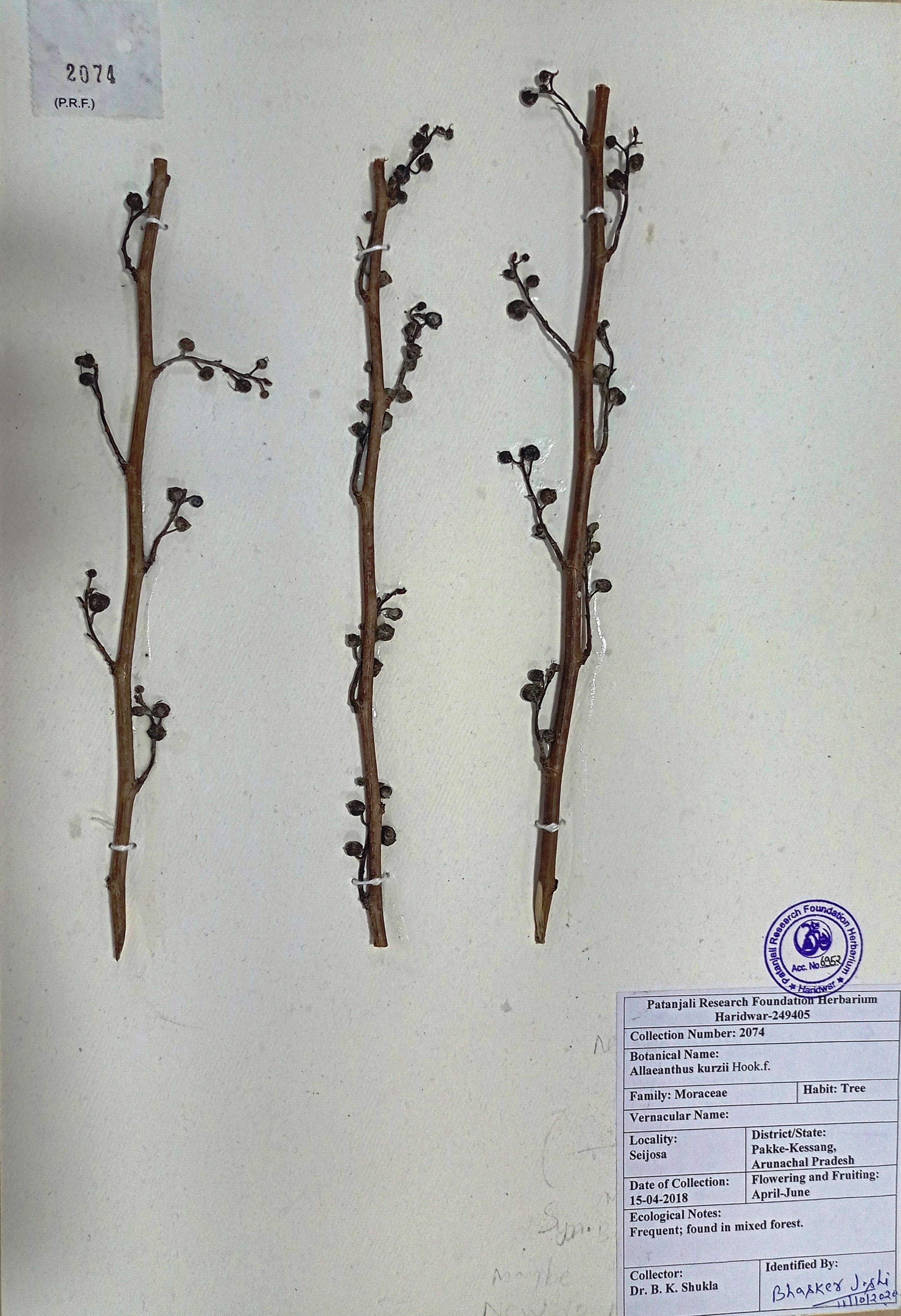
Figure 1. Allaeanthus kurzii Hook.f.
2. Ardisia grandifolia A.DC. in Trans. Linn. Soc. London 17: 122. 1834; C.B.Clarke in Hook.f., Fl. Brit. India 3: 526. 1882; Kanjilal et al., Fl. Assam 3: 178. 1939. A. macrophylla Wall., Numer. List: n. 2290. 1830. Tinus grandifolia (A.DC.) Kuntze, Revis. Gen. Pl. 2: 974. 1891. (Primulaceae) (Fig. 2.)
Small shrub, up to 1.5 m high. Leaves narrowly lanceolate to lanceolate, 7-14 × 1.6-3 cm, margin crenate, acute at both ends, submarginal glands prominent in rows, glabrous, lateral nerves obscure; petiole short, up to 0.5 mm long. Flowers in axillary, terminal or subterminal panicled umbels, pinkish; pedicels minutely rusty. Calyx segments oblong, ca. 0.6 cm long. Corolla lobes acute. Fruits globose, 0.7-1.2 cm across, depressed, red.
Fl. & Fr.: March-August
Ecological Note: Frequent; found in shady places in tropical evergreen forests.
Specimen Examined: Arunachal Pradesh, Pakke-Kessang District, Seijosa; Acharya Balkrishna 2126.
Note: In J.D. Hooker’s, Flora of British India the occurrence of this species is mentioned from Tavoy (Myanmar). Kanjilal et al. (1939) mentioned the occurrence of this species from Cachar Hills, Assam and Manipur.
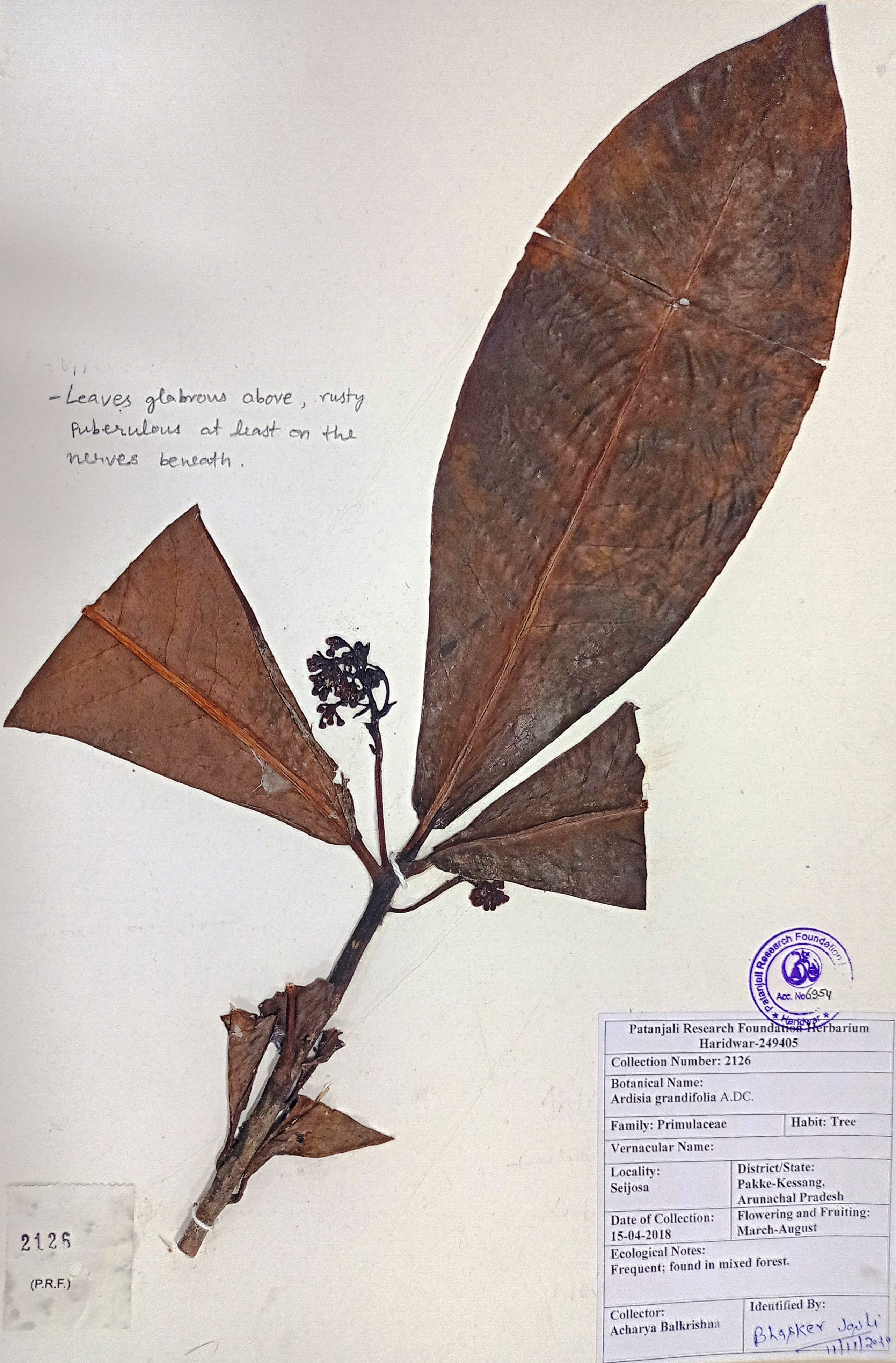
Figure 2. Ardisia grandifolia A.DC.
3. Derris marginata (Roxb.) Benth. in Miq., Pl. Jungh. 2: 252. 1852; Baker in Hook.f., Fl. Brit. India 2: 245. 1878; Kanjilal et al., Fl. Assam 2: 112. 1938; Haridas. & R.R.Rao, Forest Fl. Meghalaya 1: 292. 1985. Dalbergia marginata Roxb., Fl. Ind. 3: 230. 1832. (Fabaceae) (Fig. 3.)
Evergreen liana. Branches densely lenticelled; bark dark-brown. Leaves 5- or 7-foliolate; leaflets oblong, obovate, obovate-elliptic or oblanceolate, 5-15 × 2.5-6 cm, base rounded, apex shortly and obtusely acuminate to abruptly caudate, thinly coriaceous, shining above, pale beneath; lateral nerves 6-12 pairs. Flowers 1-1.5 cm long, in axillary, 6-20 cm long, lax-flowered, glabrous, panicled racemes. Calyx shallow cup-shaped, 2-3 mm long. Corolla pale red to whitish, 0.8-1.2 cm long, glabrous. Ovary glabrescent. Pods oblong to oblong-lanceolate, 8-15 × 2-4.5 cm, acute, flat, thin, reticulately nerved, winged. Seeds 1 or 2.
Fl. & Fr.: April-January
Ecological Note: Frequent; found on slopes in open or dense forests.
Specimen Examined: Arunachal Pradesh, Pakke-Kessang District, Seijosa; Acharya Balkrishna 1380.
Note: In J.D. Hooker’s, Flora of British India the occurrence of this species is mentioned from Khasi and Sylhet (Eastern Himalaya). Kanjilal et al. (1938) mentioned the occurrence of this species from Kamrup, Assam and Khasi Hills, Meghalaya. Haridasan and Rao (1985) reported it from Meghalaya.
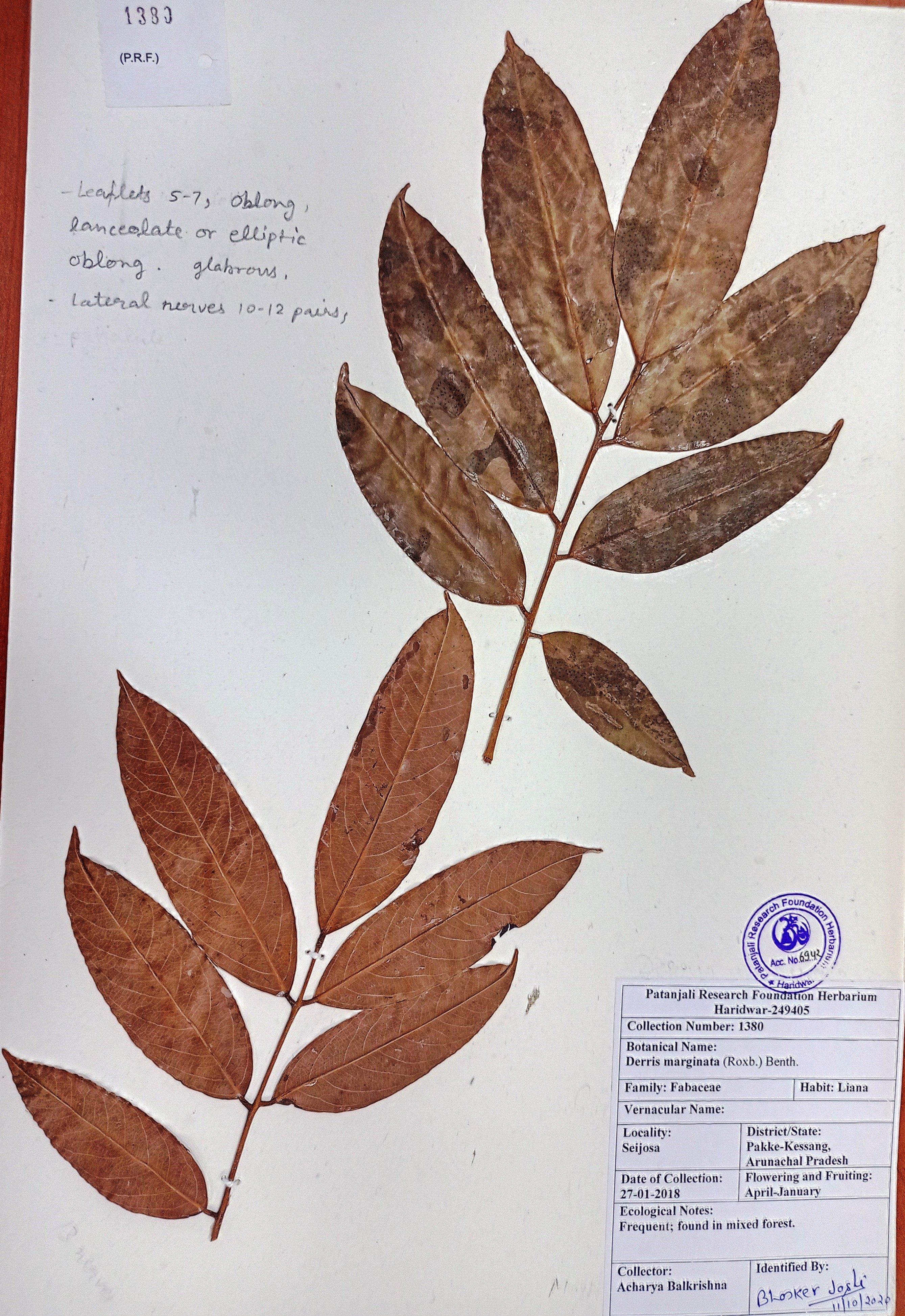
Figure 3. Derris marginata (Roxb.) Benth.
4. Gomphostemma crinitum Wall. ex Benth. in Wall., Pl. Asiat. Rar. 2: 12. 1830; Hook.f., Fl. Brit. India 4: 698. 1885. (Lamiaceae) (Fig. 4.)
Perennial herb up to 2.5 m tall. Stems erect, woody at base, obtusely quadrangular, with longitudinal grooves, with dense
stellate hairs and sometimes dendroid hairs. Leaves oblong, 15-20 × 7-9 cm, base attenuate-decurrent, margin irregularly coarse dentate, apex acute, slightly oblique, sparsely hirtellous with stellate hairs above, densely grey stellate tomentose beneath. Flowers in axillary, much branched, subsessile, ca. 5 cm across, grouped cymes; bracts linear-lanceolate, ca. 1 × 0.3 cm; bracteoles linear. Calyx narrowly campanulate, 1-1.2 cm long, somewhat enlarged in fruit; teeth linear. Corolla yellow, slightly straight, 2-2.5 cm long. Nutlet 1 at maturity, ca. 0.6 × 0.3 cm, smooth, glabrous.
Fl. & Fr.: October-March
Ecological Note: Frequent; found in mixed forests.
Specimen Examined: Arunachal Pradesh, Pakke-Kessang District, Seijosa; Acharya Balkrishna 1771.
Note: In J.D. Hooker’s, Flora of British India the occurrence of this species is mentioned from Tavoy (Myanmar) and from Malacca, Mount Ophir and Cheboo Forest (Malaysia). But in some e-literature like Checklist of Plants of India (https://efloraindia.bsi.gov.in/eFlora/speciesDesc_PCL.action?species_id=18831) and eFlora China (http://www.efloras.org/florataxon.aspx?flora_id=2&taxon_id=200019689) the distribution of this species is mentioned in India.
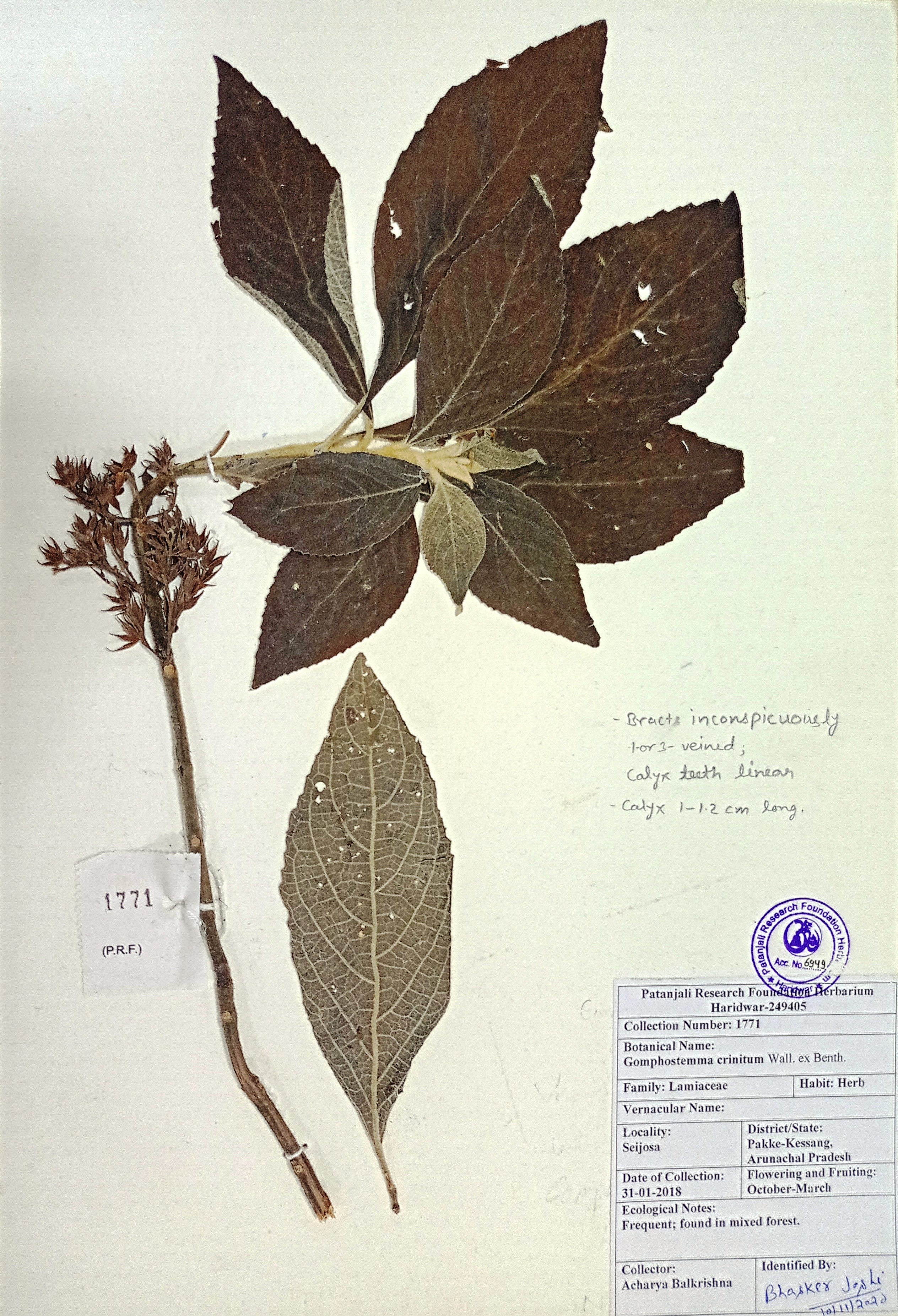
Figure 4. Gomphostemma crinitum Wall. ex Benth.
5. Lasianthus jackianus Wight in Calcutta J. Nat. Hist. 6: 502. 1846; Hook.f., Fl. Brit. India 3: 180. 1880. Jack’s Lasianthus (Eng.) (Rubiaceae) (Fig. 5.)
Large shrub, up to 3 m tall. Branchlets hirsute, quadrangular when young, terete on maturity. Leaves opposite, oblong, elliptic-oblong or ovate-oblong, 11-19 × 2-5 cm, base unequally-rounded or subacute, margin entire, apex acuminate or caudate-acuminate, thinly coriaceous, hirsute; lateral nerves 6-8 pairs, subparallel, arcuate; stipules ovate, 4.5-6 × 2.5-4 cm, acute; petiole very short, hirsute. Flowers ca. 0.7 cm long, sessile, in axillary, sessile, 2-5-flowered cymes; bracts foliaceous, ovate, ovate-lanceolate, 2-5 × 0.5-1 cm, base rounded, apex acuminate, thinly coriaceous, hirsute; midrib slender. Hypanthium obovoid, 1 mm long, tomentose. Calyx 4-lobed, tomentose; lobes ovate-elliptic, acute; tube ca. 0.5 × 0.5 mm. Corolla 4-lobed; lobes ovate-elliptic, 0.2 cm long, tomentose above, puberulous beneath; tube ca. 0.4 cm long, glabrous above, puberulous beneath at throat. Stamens 4, slightly exserted; filaments adnate at throat, 0.5 mm long; anthers oblong. Ovary 4-loculed, obovoid, 0.5 mm long; style flattened, 3.4 mm long, wider above; stigma 4-lobed; lobes linear-oblong, ca. 0.5 mm long, papillose. Fruits 4-ridged and grooved, globose, ca. 5 × 4 mm, crowned with persistent calyx lobes; pyrenes 4, unequal in size, wrinkled. Seeds oblong, 3 mm long, acute at both ends.
Ecological Note: Frequent; in mixed forest.
Fl. & Fr.: March-June
Specimen Examined: Arunachal Pradesh, Pakke-Kessang District, Seijosa; Bhasker Joshi 2211.
Note: In J.D. Hooker’s, Flora of British India the occurrence of this species is mentioned from Nilgherry Mountain and from Sisparah Ghat. But in some e-literature like Checklist of Plants of India (https://efloraindia.bsi.gov.in/eFlora/speciesDesc_PCL.action?species_id=17835) the distribution of this species is mentioned in India.
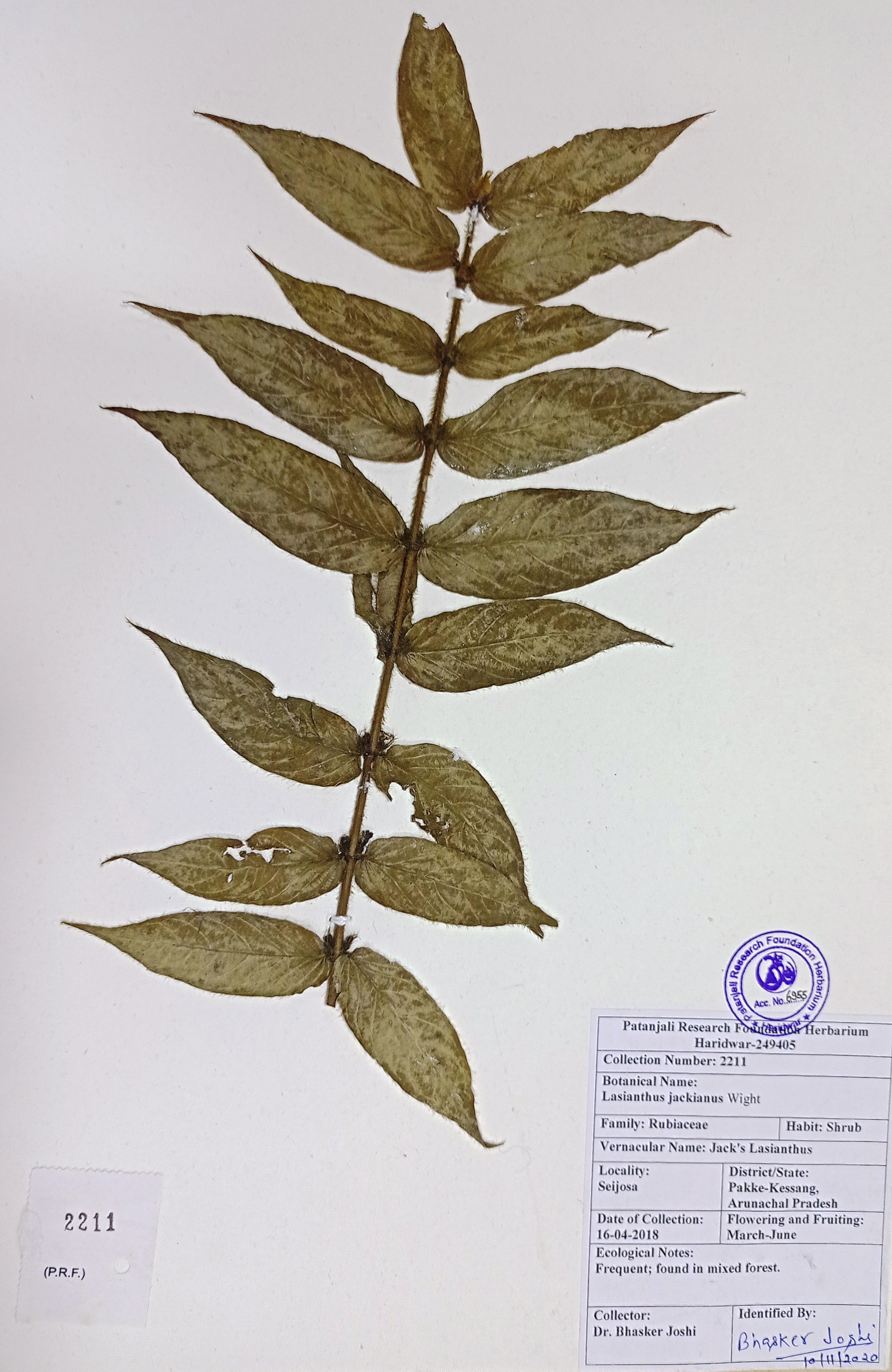
Figure 5. Lasianthus jackianus Wight
6. Memecylon cerasiforme Kurz, Forest Fl. Burma 1: 516. 1877; C.B.Clarke in Hook.f., Fl. Brit. India 2: 557. 1879; Kanjilal et al., Fl. Assam 2: 305. 1938; Haridas. & R.R.Rao, Forest Fl. Meghalaya 1: 408. 1985. Kakoi-chera (Asm.) (Melastomataceae) (Fig. 6.)
Tree, up to 15 m tall; bark grey, with vertical fissures. Bole straight. Leaves opposite, elliptic, broadly elliptic-lanceolate to oblong, 7-15 × 3-6 cm, base cuneate to attenuate, margin entire, slightly recurved, apex acuminate to caudate-acuminate, dark green, glossy above, pale green beneath, glabrous; petiole glabrous, channelled. Inflorescence axillary, terminal and in fallen leaf axils, lax, simple or compound, 4-30-flowered, peduncled cymes. Flowers bisexual, 0.5-0.7 cm across; bracts triangular. Calyx infundibuliform, shallowly 4-lobed; lobes ca. 1 mm long, strongly ridged inside. Petals 4, spreading or deflexed, sub-orbicular, ca. 4 mm long, acute, pale purplish-white inside, white outside. Stamens 8, light bluish-purple. Ovary subglobose, unilocular; style subulate, pale bluish-white; stigma white. Berries subglobose, up to 1.5 cm long, glabrous, pale green, turning dark purplish-black when ripe.
Fl. & Fr.: August-January
Ecological Note: Frequent; in mixed forest.
Specimen Examined: Arunachal Pradesh, Pakke-Kessang District, Seijosa; Acharya Balkrishna 1376.
Note: In J.D. Hooker’s, Flora of British India the occurrence of this species is mentioned from Chittagong (Bangladesh). Kanjilal et al. (1938) mentioned the occurrence of this species from Sibsagar, Assam. Haridasan & Rao (1985) reported it from Meghalaya.
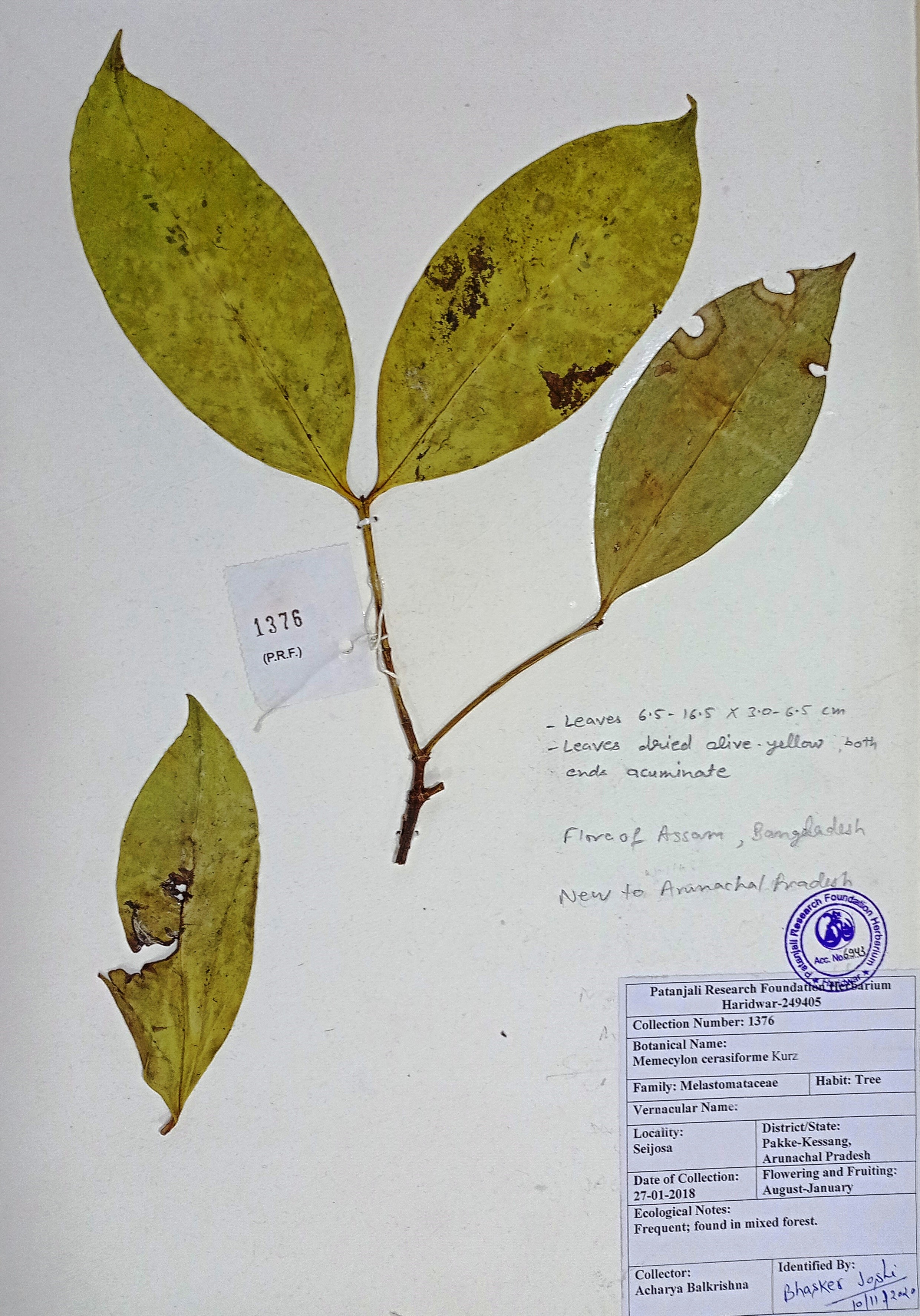
Figure 6. Memecylon cerasiforme Kurz
7. Morinda coreia Buch.-Ham. in Trans. Linn. Soc. London 13: 537. 1822. M. tinctoria Roxb., Fl. Ind. 2: 197. 1824; Hook.f., Fl. Brit. India 3: 156. 1880; Deb, Fl. Tripura 2: 67. 1983. Morinda Tree (Eng.); Aal, Achi (Hin.) (Rubiaceae) (Fig. 7.)
Evergreen, large shrub or sometimes small tree reaching up to 7 m; bark rough with deep longitudinal cuts. Stem crooked, short. Leaves opposite, elliptic to oblong, 10-25× 7-16 cm, base attenuate, apex acute, tomentose beneath; lateral nerves 8-10 pairs. Flowers tubular, white, scented, in leaf opposed, pedunculate, 3-5 cm across globose heads; peduncle 2-3 cm long. Corolla usually 5-lobed; lobes oblong, ca. 1 cm long; tube up to 1.5 cm long. Stamens as many as petals. Fruit a syncarp, globose, 2-2.5 cm across, green.
Fl. & Fr.: March-October
Ecological Note: Common; in mixed forests.
Specimen Examined: Arunachal Pradesh, Pakke-Kessang District, Seijosa; Bhasker Joshi 2083.
Note: In J.D. Hooker’s, Flora of British India the occurrence of this species is mentioned from throughout India from the Sutlej eastwards, and southwards to Ceylon and Malacca. Deb (1983) reported it from Tripura.
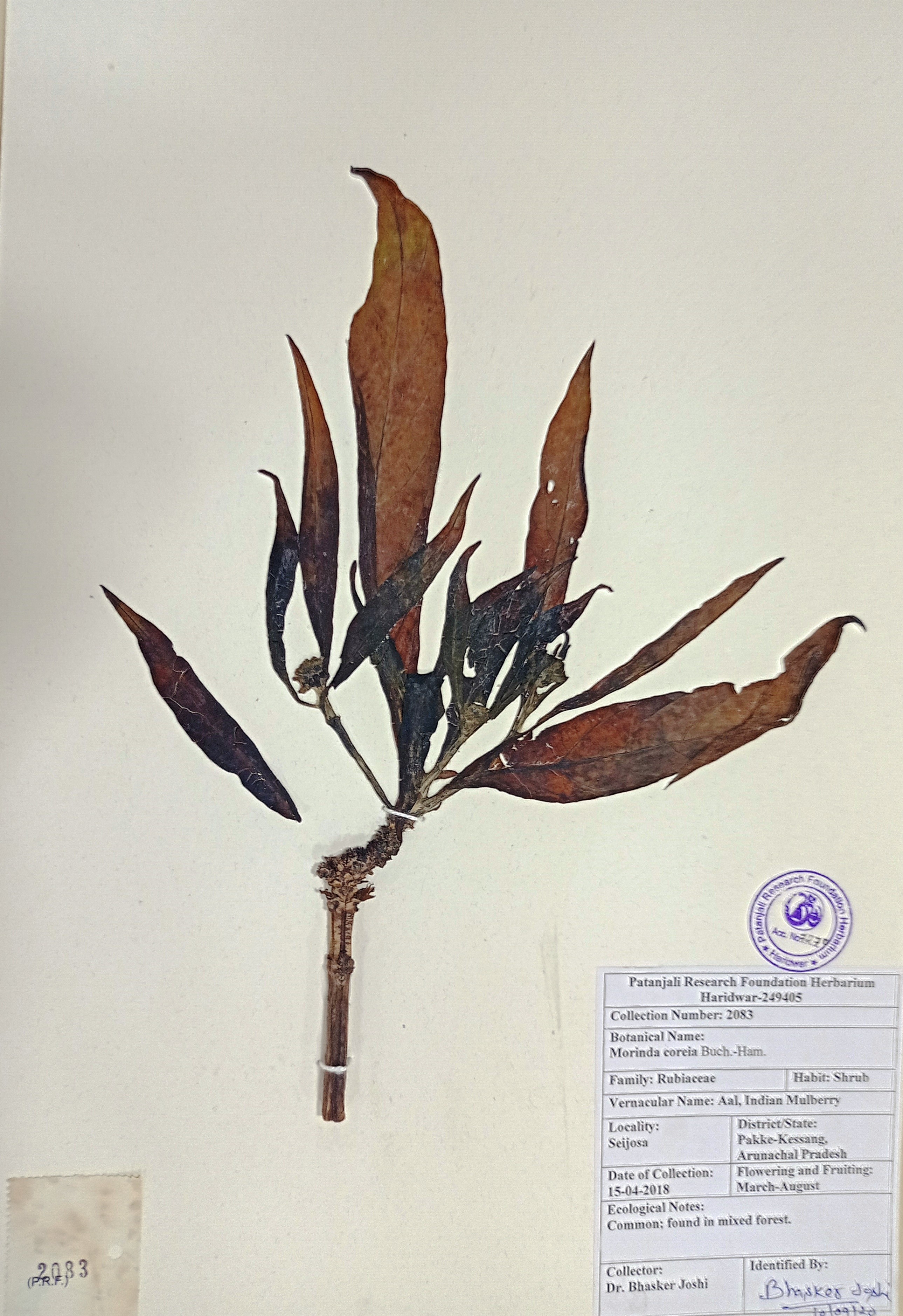
Figure 7. Morinda coreia Buch.-Ham.
8. Nekemias rubifolia (Wall.) J.Wen & Z.L.Nie in PhytoKeys 42: 17. 2014. Vitis rubifolia Wall. in Roxb., Fl. Ind. 2: 480. 1824; M.A.Lawson in Hook.f., Fl. Brit. India 1: 663. 1875; Kanjilal et al., Fl. Assam 1: 302. 1934. Ampelopsis rubifolia (Wall.) Planch. in DC., Monogr. Phan. 5: 463. 1887; B.V.Shetty & P.Singh in N.P.Singh et al., Fl. India 5: 265. 2000; K.P.Singh in N.P.Singh et al., Fl. Mizoram 1: 369. 2002. (Vitaceae) (Fig. 8.)
Climber. Branchlets densely curly and ferruginous pilose, longitudinally 5-7-ridged; tendrils bifurcate. Leaves 1- or 2-pinnate; leaflets oval or ovate-elliptic, 4-13 × 2.2-6 cm, base rounded or slightly cordate, margin 5-15-toothed on each side, apex acute to acuminate, pubescent above when young, later glabrescent, densely ferruginous pilose beneath; lateral nerves 5-7 pairs; petiole 1-8 cm long, densely curly and ferruginous pilose. Inflorescence pseudoterminal or leaf-opposed, corymbose cymes; peduncle 2-6 cm long, densely curly and ferruginous pilose; pedicels densely ferruginous pilose, 1-1.5 mm long. Calyx nearly glabrous. Petals ovate-elliptic, 1.5-1.8 mm long, pubescent. Berries globose, 1-1.5 cm across. Seeds 1-4, obovoid, surface with raised and obtuse ribs.
Fl. & Fr.: September-April
Ecological Note: Common; in mixed forests.
Specimen Examined: Arunachal Pradesh, Pakke-Kessang District, Seijosa; Rama Shankar 2503.
Note: In J.D. Hooker’s, Flora of British India the occurrence of this species is mentioned from Khasia hills (Meghalaya), Assam and Bangladesh. Kanjilal et al. (1934) mentioned the occurrence of this species from Sibsagar (Assam), Naga Hills (Nagaland) and Khasi Hills (Meghalaya) in evergreen mixed forests. Singh (2002) reported it from Mizoram.
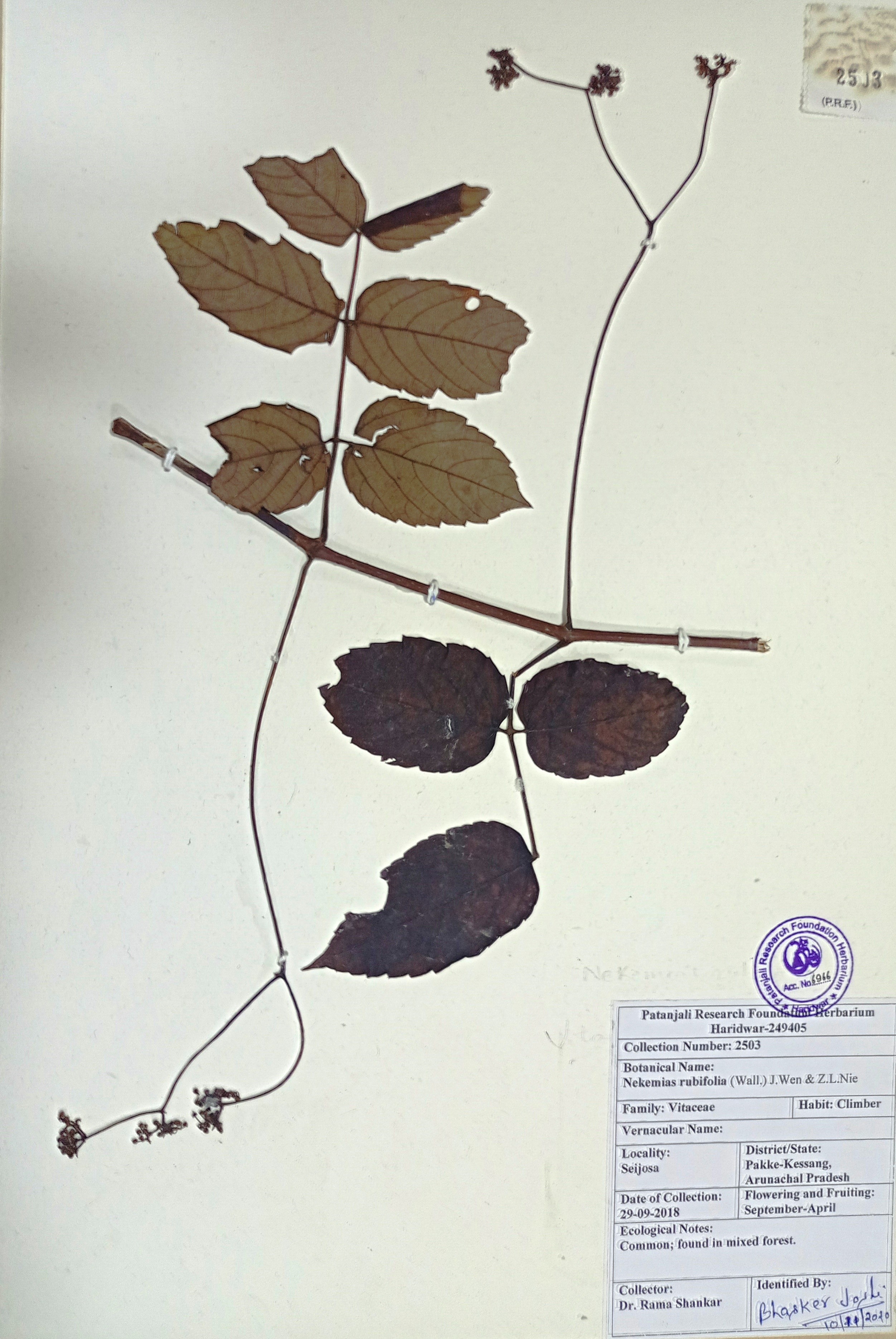
Figure 8. Nekemias rubifolia (Wall.) J.Wen & Z.L.Nie
9. Sterculia lanceifolia Roxb., Fl. Ind. 3: 150. 1832. S. roxburghii Wall., Pl. Asiat. Rar. 3: 39. 1832; Mast. in Hook.f., Fl. Brit. India 1: 356. 1874; Haridas. & R.R.Rao, Forest Fl. Meghalaya 1: 150. 1985; Kanjilal et al., Fl. Assam 1(1): 153. 1934. Taglum (Adi); Nag-phona (Asm.) (Malvaceae) (Fig. 9.)
Small or middle-sized tree, up to 15 m tall; bark grey, somewhat rough outside. Leaves linear-lanceolate, lanceolate-oblong or lanceolate, 10-20 × 2.5-7 cm, base obtuse or rounded margin entire, apex shortly caudate-acuminate, glabrous; petiole terete, 2.5-3 cm long, swollen at both ends. Flowers ca. 1.2 cm across, brick-red, in axillary, 5-7 cm long, few-flowered racemes; pedicels 0.5-0.8 cm long, bracteate slender, stellately hirsute. Calyx campanulate, 5-partite; lobes oblong-lanceolate, ca. 7 mm long. Male flowers: androgynophore glabrous, curved. Female flowers: ovary globose. Follicles oblong-lanceolate to oblong, 6-7 × 2-4 cm, beaked, densely red hirsute. Seeds 4-8, ovoid, black.
Fl. & Fr.: April-August
Ecological Note: Common; near river bank, by the roadside and in open places.
Specimen Examined: India: Arunachal Pradesh, Pakke-Kessang District, Seijosa; Rajesh Kumar Mishra 2167.
Note: In J.D. Hooker’s, Flora of British India the occurrence of this species is mentioned from Sikkim, Assam and Sylhet (Bangladesh). Kanjilal et al. (1934) mentioned the occurrence of this species from Lakhimpur, Sibsagar (Assam) and Garo Hills (Meghalaya) in evergreen mixed forests. Haridasan and Rao (1985) reported it from evergreen crests at lower elevations, in almost all ranges of Meghalaya except Shillong range. Srivastava (1998) reported it from Sikkim.
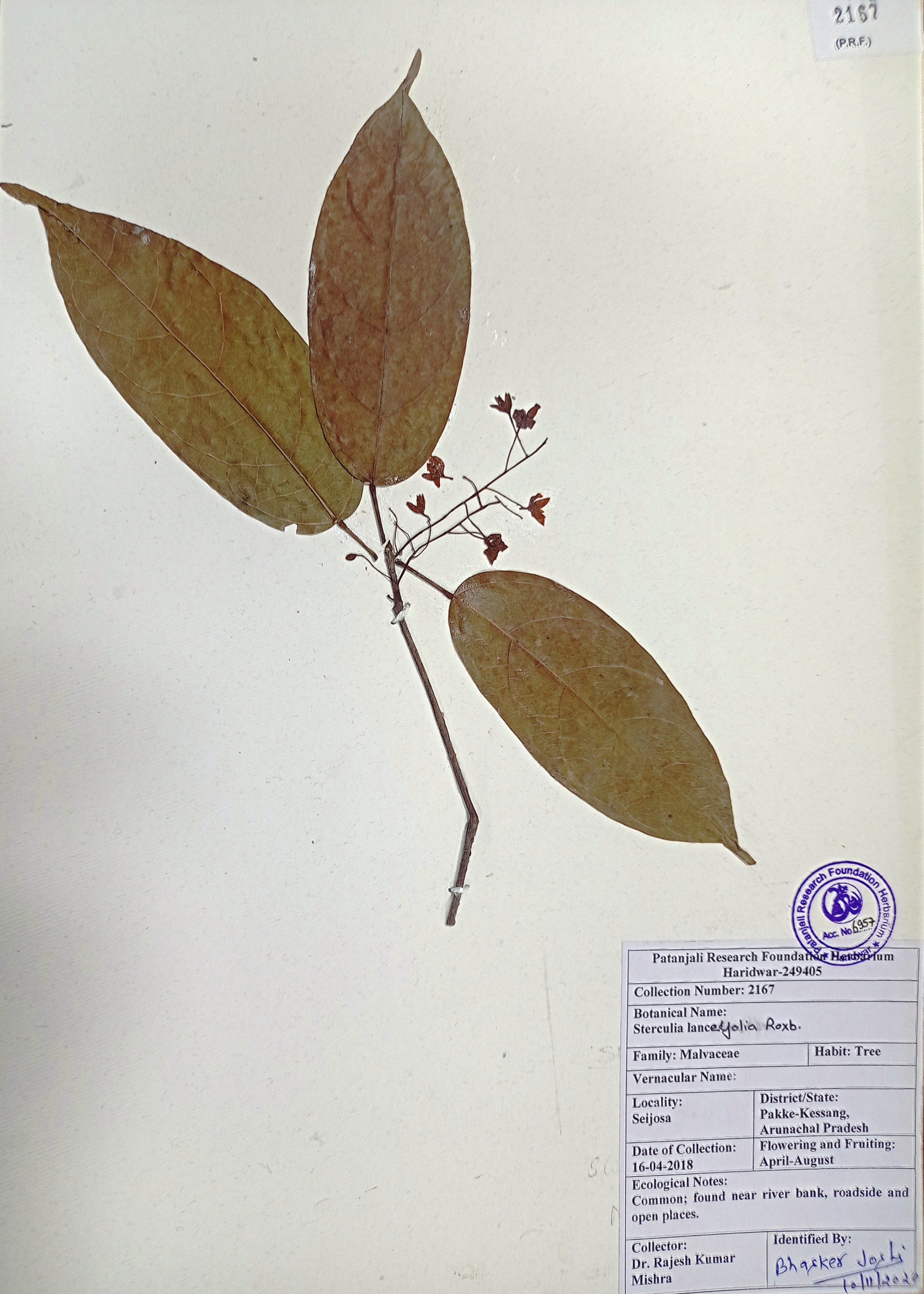
Figure 9. Sterculia lanceifolia Roxb.
10. Uvaria lamponga Scheff. in Natuurk. Tijdschr. Ned.-Indie 31: 2. 1869. U. andamanica King in J. Asiat. Soc. Bengal, Pt. 2, Nat. Hist. 61: 21. 1892; D.Mitra in B.D.Sharma et al., Fl. India 1: 289. 1993; Karthik. et al., Flow. Pl. India 1: 97. 2009. (Fig. 10.)
Family: Annonaceae
Scandent shrub. Leaves oblong to oblanceolate, base narrowed, apex shortly acuminate, 15-20 × 5-7 cm, glabrous above except the midrib and lateral nerves, stellate pubescent on the mid-rib and lateral nerves. Inflorescence terminal or axillary cymes, rarely flowers solitary, stellate rusty tomentose; pedicels ca. 4 mm long in bud; bracts solitary, orbicular. Sepals 3, ca. 4 mm long in bud, orbicular, glabrous inside. Petals 6, outers ca. 5 mm diam. in bud; inners smaller, orbicular, fleshy, puberulous outside. Stamens numerous, ca. 1.5 mm long; connectives rounded and flat on top. Ripe carpels many, ca. 3 cm long, oblong, slightly tuberculate, stellately rusty tomentose, constricted between seeds. Seeds ca. 8, in 2 rows, plano-convex.
Ecological Note: Rare; in mixed forest.
Fl. & Fr.: Not seen
Specimen Examined: Arunachal Pradesh, Pakke-Kessang District, Seijosa; Aqib 5623.
Note: Earlier this species was reported from Andaman Islands (India) by King (Meade & Parnell, 2018). This species is similar to U. concava Teijsm. & Binn. and U. macropoda Hook.f. & Thomson, but, the shorter stipe and floccose indumentum on undersurface of the leaves make it easily distinguishable from both the species.
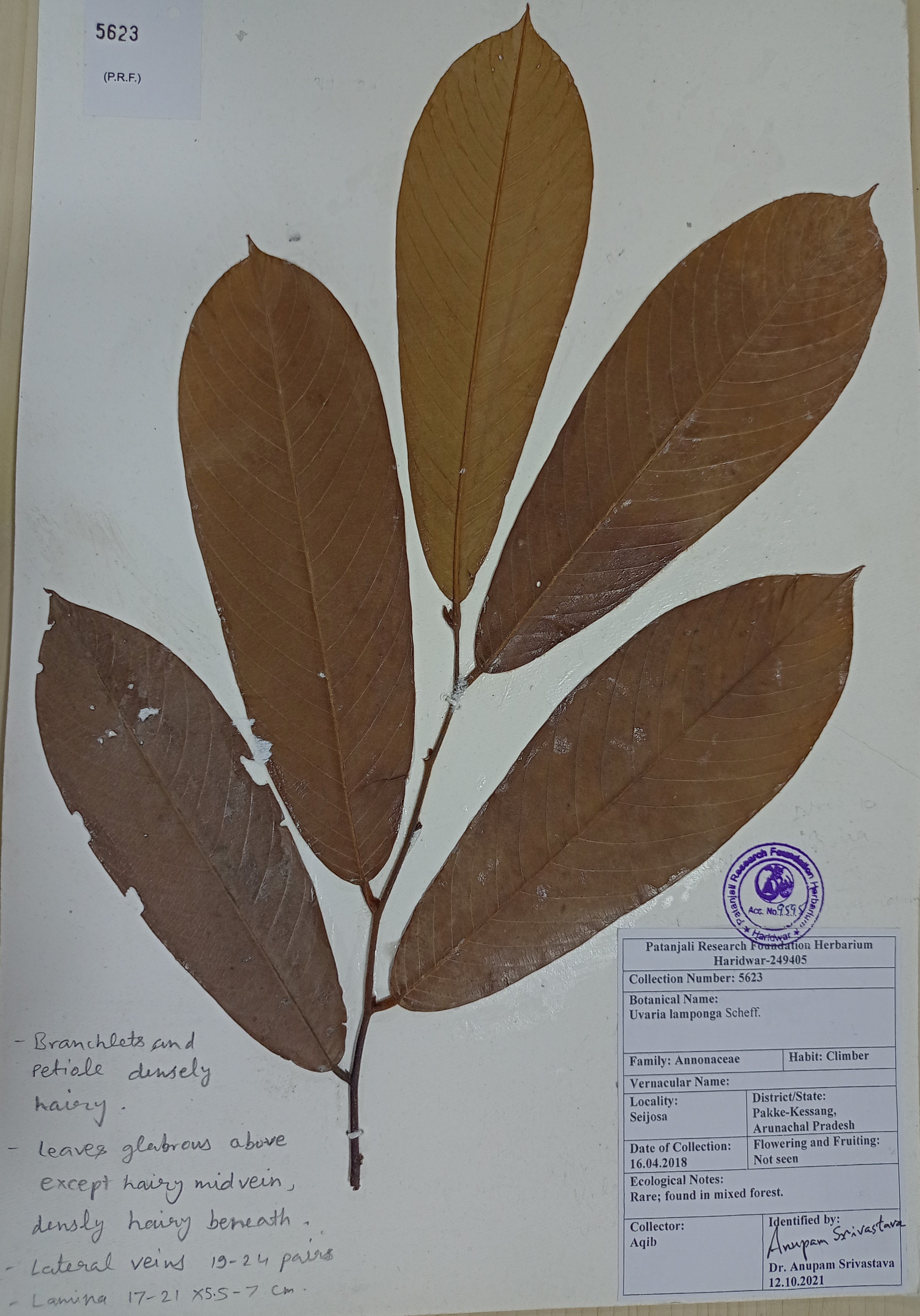
Figure 10. Uvaria lamponga Scheff.
Acknowledgement
Authors are grateful to Swami Ramdev Ji, Patanjali Yogpeeth, Haridwar for providing all the necessary facilities for research work in Patanjali Research Institute, Haridwar.









